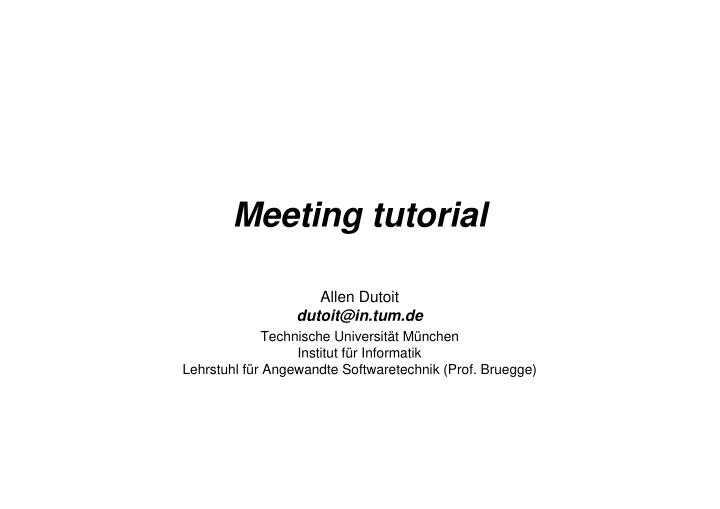



Meeting tutorial Allen Dutoit dutoit@in.tum.de Technische Universität München Institut für Informatik Lehrstuhl für Angewandte Softwaretechnik (Prof. Bruegge)
Overview: communication, part 2 • Now that we use groupware, why meet? • Types of meetings • Meeting roles • Preparing a meeting • Conducting a meeting • Recording a meeting • Questions? • First team meeting
Now that we use groupware, why meet? What is a meeting? “A meeting is a gathering where people speak up, say nothing, then all disagree.” Disadvantages of face to face meetings: • Low bandwidth • Difficulty to schedule • High cost • Difficulty to stay awake
Why meet? Nonverbal communication is essential... • to understand, • to negotiate, • to convince, • to motivate, • to make decisions, and • to move on.
Types of meetings in PAID Team status (weekly) • Status of each team member • Decisions on open issues • Plan for subsequent week Project status (weekly) • Same as for team status at the project level Project/client review (~monthly) • Review of deliverable (e.g., RAD , SDD , ODD ) • Formal presentations by teams
Meeting roles • Facilitator – Prepares the agenda – Interrupts people who talk too much – Gives floor to people who don’t talk enough – Uses agenda to focus the meeting and reach decisions • Minute taker – Records the discussion – Keeps track of decisions and actions items • Time keeper – Reminds meeting participants of passing time – Allows facilitator to make the discussion progress
Preparing a meeting • Primary facilitator prepares an agenda – Purpose – Desired outcome – Status items – Discussion items • Agenda on bboard 24 before meeting. • Members comment on agenda (on bboard) • Agenda is revised by facilitator.
Preparing a meeting: example agenda 1. Purpose – Become familiar with project management roles for a medium-scale project with a 2-level management hierarchy. 2. Desired outcome – Members know the difference between role and person – Roles are assigned – Regular meeting time & place is decided 3. Status – Introduction of team members 4. Discussion – Schedule regular meeting time & place – Assign meeting roles (facilitator, minute taker, time keeper) – Assign team roles (toolsmith, webmaster, document editor)
Preparing a meeting: example agenda (2)
Conducting a meeting Agenda is frozen when the meeting starts Status – Round table, each member has 1 min to describe his status – Information sharing items Discussion – Issues are negotiated and resolved, one at a time – Resolving an issue will generate action items Wrap up – Minute taker recaps actions items – Members criticize the meeting
Meeting heuristics • Listen actively – Don’t pick a fight if you do not disagree • Participate actively – Say what you think now, later will be too late • Be punctual • Be willing to compromise • Share responsibility • Check process and ground rules
Recording the meeting Minute taker records the meetings including: • Status items • Issues that were discussed • Proposals addressing the issues (including the discarded ones) • Arguments for and against each proposal • Resolutions of each issues • Action items implementing resolutions Minute taker posts the recorded minutes as a response to the meeting agenda within 24 hours of the meeting
What now? • First team meeting with your coach • Your coach will be the facilitator for the first team meeting • A volunteer designated by the coach will be the minute taker • Only core teams meet now, cross functional teams will meet later
Recommend
More recommend